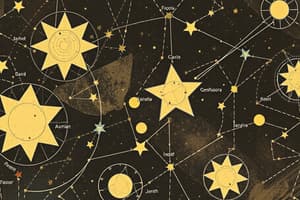Podcast
Questions and Answers
What defines the classification of stars into groups such as O, B, A, F, G, K, and M?
What defines the classification of stars into groups such as O, B, A, F, G, K, and M?
- Their temperature, color, and luminosity (correct)
- Their brightness during a supernova
- Their size and gravitational pull
- Their distance from Earth
Which type of star is characterized as having an average temperature of more than 28,000 degrees Kelvin?
Which type of star is characterized as having an average temperature of more than 28,000 degrees Kelvin?
- M-class stars
- O-class stars (correct)
- G-class stars
- K-class stars
What is a significant characteristic of O-class stars?
What is a significant characteristic of O-class stars?
- They have the longest life cycles
- They are the oldest types of stars
- They exhaust their fuel quickly (correct)
- They are predominantly red in color
Which type of star has an average temperature of fewer than 3,500 degrees Kelvin?
Which type of star has an average temperature of fewer than 3,500 degrees Kelvin?
Why are O-class stars relatively rare in the universe?
Why are O-class stars relatively rare in the universe?
What is the primary characteristic of B-class stars?
What is the primary characteristic of B-class stars?
Which type of star is categorized as having a surface temperature between 6,000 to 7,000 degrees Kelvin?
Which type of star is categorized as having a surface temperature between 6,000 to 7,000 degrees Kelvin?
Which statement accurately describes K-class stars?
Which statement accurately describes K-class stars?
What is the main characteristic of supergiant stars?
What is the main characteristic of supergiant stars?
Which of the following statements about M-class stars is true?
Which of the following statements about M-class stars is true?
What phenomenon occurs when a sufficiently large star undergoes nuclear fusion until it explodes?
What phenomenon occurs when a sufficiently large star undergoes nuclear fusion until it explodes?
What is the classification of our sun based on its spectral type?
What is the classification of our sun based on its spectral type?
Which statement about the sun is correct?
Which statement about the sun is correct?
What type of core remains after a supernova event?
What type of core remains after a supernova event?
What is the estimated age of the sun?
What is the estimated age of the sun?
What characterizes brown dwarf stars compared to planets?
What characterizes brown dwarf stars compared to planets?
Which of the following is true about main-sequence stars?
Which of the following is true about main-sequence stars?
In which stage of a star's life cycle is nuclear fusion first initiated?
In which stage of a star's life cycle is nuclear fusion first initiated?
What leads to the formation of a protostar?
What leads to the formation of a protostar?
What happens to a star once it reaches the white dwarf stage?
What happens to a star once it reaches the white dwarf stage?
Flashcards are hidden until you start studying
Study Notes
Types of Stars Overview
- Stars can be categorized into seven main types based on spectral classification: O, B, A, F, G, K, and M.
- Classification is based on properties like temperature, color, and luminosity.
Spectral Classification
- O-Class Stars: Hot, blue stars with temperatures over 28,000 K; short life cycles due to high mass leading to supernova events.
- B-Class Stars: Blue-white with temperatures between 20,000-30,000 K; young and rare with short life spans.
- A-Class Stars: White stars ranging from 10,000-20,000 K; make up less than 1% of stars; visible to the naked eye.
- F-Class Stars: Whitish-yellow, 7,000-10,000 K, making up about 3% of main-sequence stars.
- G-Class Stars: Yellow stars with temperatures around 6,000-7,000 K; includes the Sun; about 8% of stars; can live billions of years.
- K-Class Stars: Orange stars, 5,000-6,000 K; relatively old; less bright than hotter classes.
- M-Class Stars: Coolest stars with temperatures below 3,500 K; large red giants; represent approximately 75% of stars.
Types of Stars by Size
- Supergiants: Enormous stars, 10-70 times more massive than the Sun; blue or red-orange; short life spans (10 to 50 million years).
- Giant Stars: Large but smaller than supergiants; have short life spans; can be K and M-class.
- Main-Sequence White Dwarfs: Small, dense stars with very high temperatures (over 100,000 K); comparable in size to Earth.
- Brown Dwarf Stars: Often mistaken for planets; low luminosity; 15 times more massive than Jupiter; cannot perform hydrogen fusion.
Types of Stars by Life Cycle
- Protostar: Initial stage where gravity forms a spherical mass from gas and dust; takes about 100,000 years to progress.
- T Tauri Star: Second stage, gaining energy from gravitational pressure; unable to perform nuclear fusion; lasts about 100 million years.
- Main-Sequence Star: Third stage with nuclear fusion igniting; long life cycles (20 to 100 billion years) depending on mass.
- Red Giant Star: Fourth stage after hydrogen fusion stops; expands up to 100 times its size; lasts about one million years.
- White Dwarf Star: Final stage; no fusion occurs; uses remaining energy before cooling to become a black dwarf.
- Neutron Star: Result of supernova in massive stars; extremely dense core made only of neutrons.
The Sun
- Classified as a G-class star with a surface temperature around 5,500 K; medium size with average brightness.
- A main-sequence star about 4.5 billion years old, positioned halfway through its life cycle.
Studying That Suits You
Use AI to generate personalized quizzes and flashcards to suit your learning preferences.




